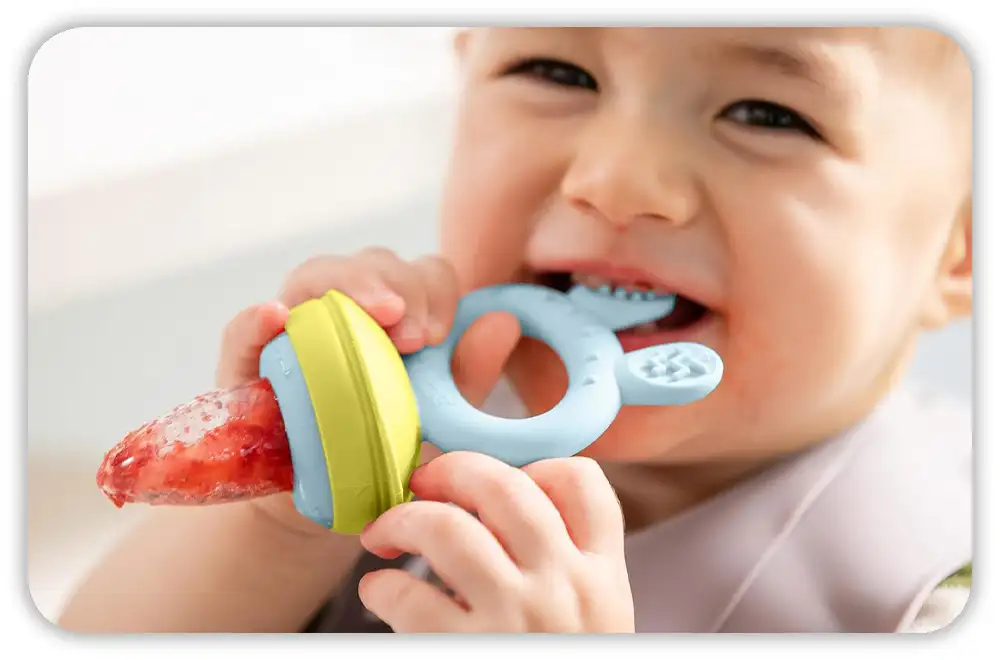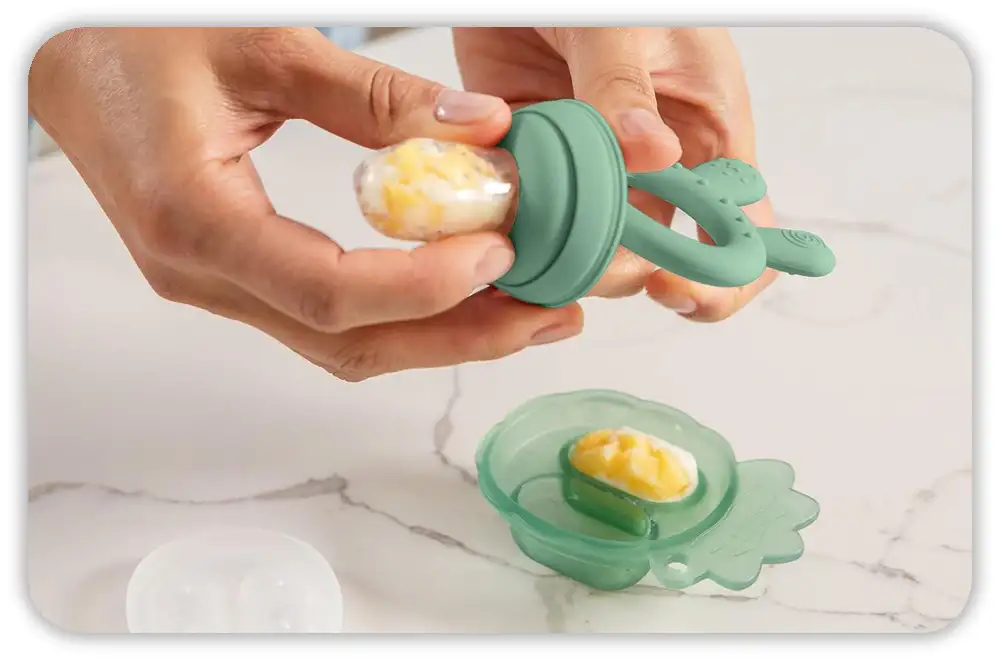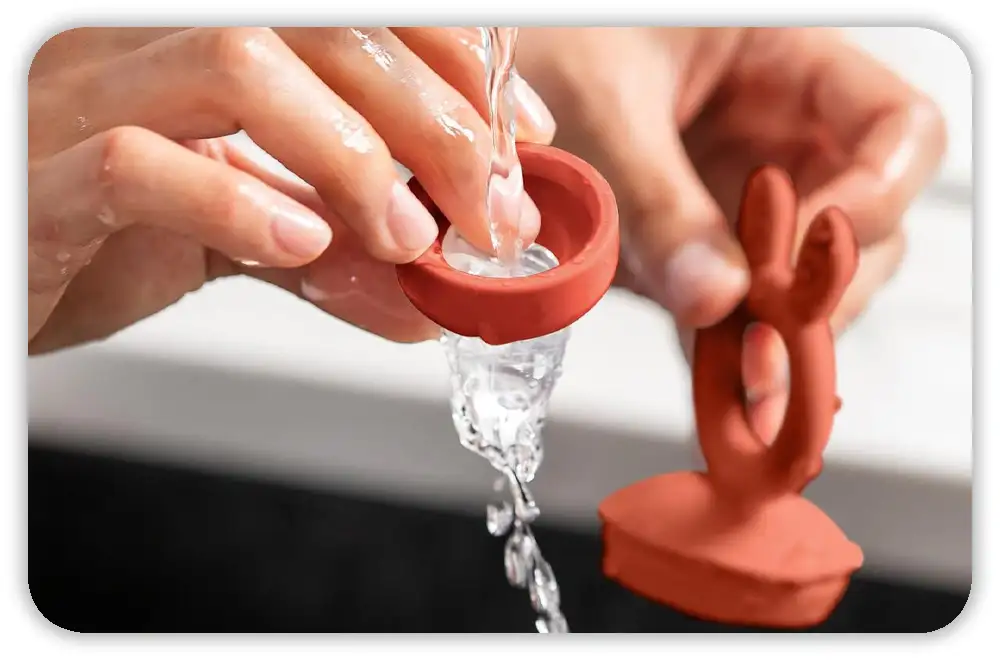Starting your baby on solids can be a mix of joy and nerves. It’s exciting because your little one will taste something other than milk. But you might also worry. Will they choke? Will it be messy? Will they like it?
That’s when I found the Haakaa Fresh Food Feeder. At first, it looked simple. It’s a small silicone pouch with holes. It’s made for tiny hands and tiny mouths. The idea is big: let babies try new tastes in a safe way. And you don’t have to hover with a spoon or a wipe.
In this guide, I’ll share what I learned from using it. You’ll see what works, what doesn’t, and how it compares to other feeders. This way, you can decide if it belongs in your baby gear.
Table of Contents
What Is the Haakaa Fresh Food Feeder?
If you’ve never seen one, imagine a small silicone pouch with tiny holes. It’s attached to a handle made for little hands. You place soft foods inside—like ripe fruit, steamed veggies, or even frozen breast milk. Then your baby can chew and suck out the flavors, safely.
It’s made for babies starting solids, usually around 4–6 months, depending on readiness. The idea is simple: give babies the taste and nutrition of real food without the choking risk. It also keeps snack time tidier, especially when you’re out and about.
Why Parents Ask: “Is the Haakaa Baby Feeder Good?”

When you start solids, a few worries pop up again and again:
- Will my baby choke?
- Will it be messy?
- Is it safe to use?
Haakaa’s marketing speaks to those fears. They point out the food-grade silicone, the locking top, and the easy-to-clean design. It works—scroll through any U.S. parenting group on Facebook, and you’ll see parents trading ideas for what to put inside. Popular picks include frozen mango chunks and pureed sweet potato.
I first heard about it in a moms’ group. I was nervous about choking hazards, and the promise of “safe self-feeding” gave me the push I needed to start solids without stressing over every bite.
The Safety Factor: Materials & Design
The Haakaa feeder is made from 100% food-grade silicone. It’s free from BPA, PVC, and phthalates—no hidden nasties in what your baby chews on.
Its safety comes down to details: small holes that let only tiny bits through, and a twist-and-lock top that stays shut, even if your baby tosses it.
Silicone also beats mesh feeders for hygiene. Mesh can trap food, making it harder to clean and more likely to smell. Silicone rinses clean in seconds and is safe for the dishwasher or sterilizer. For me, that was huge—less scrubbing means more time enjoying snack time with my baby.
Real Developmental Benefits
The Haakaa feeder is more than a snack holder—it can help your baby build skills.

The big wins:
- Encourages self-feeding. Babies can hold the handle, lift it to their mouth, and explore at their own pace.
- Boosts fine motor skills. Holding, twisting, and chewing help with hand-eye coordination.
- Safe flavor exploration. Your baby can try new tastes without the worry of big chunks.
When I first gave it to my baby, she sat in her high chair, gripping it with both hands like a prize. It was the first time she fed herself without me hovering with a spoon.
But here’s the catch:
The feeder doesn’t fully teach chewing or how to handle textures. Since the food comes through tiny holes, babies don’t always get the practice of eating larger bites. Some feeding therapists suggest using it as a first step—not the only way your baby eats solids.
Parent-Approved Uses for the Haakaa Feeder
After a while, I found some favorite ways to use ours—ones other parents liked too:
- Teething relief. Fill it with frozen breast milk, formula, or pureed fruit for a soothing chew.
- Introducing tricky foods. Mango, blueberries, or watermelon are safer and easier in the feeder.
- On-the-go snack control. Perfect for car rides, park trips, or restaurants when you want to avoid a banana-covered stroller.
One summer road trip, I packed two feeders—one with frozen cantaloupe and one with mashed avocado. My baby was happy for miles, and my back seat stayed cleaner than I thought possible.
Common Complaints & Drawbacks

It’s not all sunshine and puréed peaches. Parents often mention:
- Tricky to open. The twist-and-lock lid keeps food secure but can be hard to open when your hands are full.
- Small pouch size. Fine for new eaters, but you’ll refill it more as appetites grow.
- Higher price tag. It costs more than many mesh or plastic feeders, which may be “good enough” for occasional use.
I’ll admit—sometimes I sent a cheaper backup to daycare so I wouldn’t lose my Haakaa. But at home or on outings, it was my top choice.
Haakaa vs. Other Baby Feeders
If you’ve been down the baby aisle, you know the choices are endless—mesh, silicone, twist-top, snap-on. Here’s a quick side-by-side of the ones I’ve tried:
| Brand / Type | Material | Cleaning Ease | Best For | My Take |
| Haakaa | 100% silicone | Easy | Teething, travel, flavor intro | Hygienic, safe, and versatile. Worth it if you’ll use it often. |
| Munchkin Mesh | Mesh + plastic | Harder | Occasional use, soft fruit | Cheap backup, but food sticks in mesh. |
| Dr. Brown’s | Silicone | Easy | Starter solids | Solid choice, but smaller handle. |
| Boon Pulp | Silicone + plastic | Easy | Everyday snacks | Fun colors, softer silicone, but not as sturdy as Haakaa. |
Where Haakaa wins:
- All-silicone design means no hidden food bits.
- Works for teething and solids.
- Handle is perfect for tiny hands.
Where others are “good enough”:
- If you only use a feeder sometimes, a cheaper mesh version is fine.
- For older babies who chew well, you might not need a premium feeder.
When my baby was 8 months old, we kept a mesh feeder in the diaper bag “just in case.” But at home, the Haakaa was my first choice—less mess and no scrubbing battles.
How to Use the Haakaa Feeder for Maximum Benefit
A few simple tips can make a big difference:
DO:
- Start with soft, ripe fruits like banana or pear.
- Try frozen purées for teething relief.
- Always supervise your baby.
DON’T:
- Overfill—it makes sucking harder for little mouths.
- Use it as the only way to give solids. Babies need texture practice too.
- Forget to check for wear. Silicone can tear over time.
Age-appropriate ideas:
- 4–6 months: Steamed sweet potato, ripe banana, frozen breast milk pops.
- 6–9 months: Mango chunks, berries, avocado.
- 9–12 months: Soft cheese, cooked pasta, melon.
When I mixed feeder time with spoon feeding and finger foods, my baby got safe bites plus real texture practice. It was the best balance for us.
Final Verdict: Is the Haakaa Feeder Worth It?
Yes—the Haakaa Fresh Food Feeder is a safe, premium, and parent-friendly tool for starting solids. It’s great if you want less mess and more control over first foods. But it works best as a supplement, not the only way your baby eats.
I recommend it if you:
- Want an easy-to-clean, hygienic feeder.
- Need teething relief built into snack time.
- Plan to use it often enough to justify the cost.
Skip it if you:
- Only need a feeder sometimes.
- Your baby already eats finger foods confidently.
For us, the Haakaa made early solids less stressful and more fun—worth every penny in those first messy months.
FAQs – Is Haakaa Good for Baby Feeder Good?
Is the Haakaa Fresh Food Feeder safe for my baby?
Yes. It’s made from 100% food-grade silicone, BPA-free, and designed with small holes to prevent choking.
At what age can my baby start using the Haakaa feeder?
Most babies can start around 4–6 months, depending on readiness for solids. Always check with your pediatrician first.
Can I use the Haakaa feeder for teething relief?
Absolutely. Fill it with frozen breast milk, formula, or puréed fruit to soothe sore gums safely.
Is the Haakaa feeder better than a mesh feeder?
Many parents prefer Haakaa for hygiene and ease of cleaning. Mesh feeders can trap food and are harder to scrub.
How do I clean the Haakaa feeder?
Rinse right after use, then wash with warm soapy water or place in the dishwasher. It’s also safe to sterilize.

